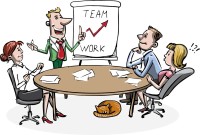- Home
- Business Processes
- Industry Knowledge
- Aerospace Industry
- Automotive Industry
- Banking Domain
- BFSI Industry
- Consumer/ FMCG Industry
- Chemicals Industry
- Engineering & Construction
- Energy Industry
- Education Domain
- Finance Domain
- Hospitality Domain
- Healthcare Industry
- Insurance Domain
- Retail Industry
- Travel and Tourism Domain
- Telecom Industry
- Leadership Skills
- eLearning
- Home
- Leadership
- Team Leadership
- Concept of Innovation
Concept of Innovation
In today's innovation-driven economy, understanding how to generate great ideas has become an urgent managerial priority. Managers need to encourage and champion ideas and need to help their organizations incorporate diverse perspectives, which spur creative insights and facilitate creative collaboration by harnessing new technologies. Innovation is the embodiment, combination, and/or synthesis of knowledge in original, relevant, valued new products, processes, or services.
Meaning of Innovation
Innovation can be observed as an implementation of ideas that originate from creative processes. Innovation is the embodiment, combination, and/or synthesis of knowledge in original, relevant, valued new products, processes, or services. It can be defined as the process of translating a novel and creative ideas or invention into a good or service that creates value or for which customers will pay. Creativity is a process you employ to improve your problem-solving. So you're not done until your creative efforts have produced a product, service, or process that answers the original need or solves the problem you identified at the outset. It relates to the commercialization of creative invention which occurs if someone improves on or makes a significant contribution to existing products, processes, or services.
Most successful innovation is the result of a conscious, purposeful search. Some areas represent more fertile ground than others. Innovation is thus the oxygen and core process of entrepreneurship.
Different ways in which innovation can be described:
Innovation Described in Words:
- Original
- Unexpected
- Fresh
- Thinking Differently
- Never been thought of before
- Never been seen before
- Creative
- New
- Useful
Innovation Described in Reactions:
- Isn't that clever
- What a great idea
- I'll actually buy this thing
- Why didn't anyone ever think of doing if before?
- Challenging conventional notions of how things have been done before
- Bringing ideas from one industry to another, or from one geographic region to another
- Creating meaningful points of difference for products and services vs. current alternatives
- Fulfilling unmet consumer needs, by offering new ways to accomplish goals;
- Making lives or jobs easier, better, happier, more exciting, satisfying, or more productive
- Enabling brands to compete in new markets or category segments
- Delighting/ engaging/capturing imaginations of consumers to increase loyalty
Types of Innovation
Innovation motivates improvements in the functioning of an organization/business and contributes to its success.
Different types of innovation are recognized depending upon the criteria of classification. For example, when the classification is based on the object of innovation, then the types may include product/service innovation, business model innovation, process innovation, technology innovation, etc. When the extent of change is the basis of classification, then the types may be radical innovations and incremental innovation.
Whatever the classification basis, the four core innovation types are briefly discussed below:
1. Invention:
The invention can be defined as the creation of a new product or new services or the introduction of a new process for the first time. An invention is a unique or novel device, method, composition, or process. So from an organizational standpoint, it’s always important to think five years and ten years out and to be continuing to try to push that envelope even though there may not be a customer today. Innovations that may not benefit customers today could meet their needs tomorrow.
Examples: Wright Brothers-Airplane; Thomas Edison- Light bulb; Alexander Graham Bell-Telephone, Steve Jobs starting to develop the smartphone world with the iPad, Marie Curie made great researches on radioactivity, etc.
2. Extension:
The extension can be defined as new use or a different application of an already existing product, service, or process. In extension, you are no longer trying to figure out problems but helping people solve new problems and coming up with new ways of doing things. Most innovation happens here, because most of the time we are seeking to get better at what we’re already doing. We want to improve existing capabilities in existing markets, and we have a pretty clear idea of what problems need to be solved and what skill domains are required to solve them. A possible downside is that incremental innovations do not necessarily make a huge impact because they’re often just slightly better than what is already out there.
Examples: The development from the mainframe computer to the desktop, then the laptop, and more recently the notebook computer. Companies such as Amazon have become masters at this, with continuous experimentation of their web interface resulting in daily optimization of the user experience.
3. Duplication:
Innovation is the outcome of creativity and manifests itself as the fresh changes that are implemented in products, processes, or services. Duplication can be defined as the creative replication of an existing concept. It utilizes your existing technology and increases the value to the customer (features, design changes, etc.) within your existing market. Almost all companies engage in incremental innovation in one form or another.
Examples: The application of the franchise model of business worldwide, from the fast-food industry to the education sector.
4. Synthesis:
It can be defined as a combination of existing concepts and factors into a new formulation or use. Most innovations are the result of a conscious, purposeful search, not sudden illumination. Most innovations are not so much the product of sudden insights as they are the result of a conscious process that often goes through multiple stages. This innovation is amazing at increasing new customers as long as the new market is receptive. Most of the time, the risk involved in synthesis is low due to the reliance and reintroduction of proven technology. Though most of the time it requires tweaking to match the requirements of the new market.
Examples: The fax machine, which is a combination of existing technologies giving rise to a new product technique (telephone+ photocopiers= fax)
Importance of Innovation
Innovation acts as a catalyst that can make a business grow, improve services, and create dynamic products. By actively involving the customer, organizations can give momentum to the innovation process. Radical changes in the processes, products, services, and ideas can open the door to success.
Given below are some of the factors highlighting the importance of innovation:
Relevant Products
Innovation as the source of success and provides a competitive advantage to the business by ensuring that the goods and services being offered remain relevant to the customers. An organization that is not creative and innovative cannot survive in the market place. It gives birth to new industries (or swallows existing ones) and involves creating revolutionary technology. Innovations include everything from the features offered to the quality of the product and can involve both improvements to existing product lines or completely new offerings. The key is that you look to add significant value to your existing products or offer new products or services.
Competitive Advantage
Every successful business achieves competitive advantages through acts of creativity and innovation. To grow and prosper, most enterprises need to constantly improve their existing products and services through continuous innovation. For the survival of the enterprise, it needs to create new products and services to meet yet unfulfilled needs. Research shows that firms who achieve at least one new product launch per year obtain a boost to their revenue productivity of around 17%, with each new product launch adding an extra 22% to this. Investing in one’s innovation capacity had a significant impact on both the profitability of firms and their share price. Innovations often form a key part of the core competencies of the business and can provide a significant advantage over your rivals.
Meeting Customer Needs
When innovation becomes a way of life in any organization, then the organizational mindset shifts to one of relentless improvement, with an increased awareness of opportunities and possibilities for products and efficiencies. Organizations start managing the process of innovation so that the best insights and ideas are translated into innovative products, services, and ideas. There is more listening, less knee-jerk defending of old ideas, and a greater understanding of, and interest in, unmet customer needs. Innovations enhance the offering of your product or service, whether through making it easier to use, highlighting overlooked functionality, or fixing common problems. Innovations begin with a deep understanding of the customer and flow all the way through the creation of meaningful connections between you and them.
Drive a Culture of Accountability
As individuals begin to understand their roles in the innovation process, standards of performance increase, along with an increased willingness and ability to hold each other accountable. When a sustainable innovation approach is developed, the emphasis tends to shift from maintaining old successes to considering new opportunities and products- a key element in staying ahead of changing customer needs rather than always trying to catch up.
Related Links
You May Also Like
-
Collaborative leadership is all about collaborative problem-solving and decision-making or can also be defined as the leadership of a collaborative effort. . The term started to appear in the mid-1990s in response to the formation of long term public-private partnerships to rebuild public infrastructure. Learn how you can use principles of collaborative leadership to enhance your leadership skills for being an effective leader.
-
Generating Ideas using Brainstorming
The brainstorming technique was developed by Alex F. Osborn in 1957 and brainstorming means where a team of members generates a large amount of alternative fruitful ideas on a specific problem without any criticism and then evaluates each idea in terms of their pros and cons. Brainstorming techniques fall into four broad categories: visioning, exploring, modifying, and experimenting.
-
Understanding Corporate Strategy
Management outlook and procedures have been revolutionized by more and more innovations over the recent years. It is no longer possible to follow traditional approaches to develop your organization's direction, its management as well its effectiveness. Senior managers need to be good decision-makers. In this section, we introduce concepts for strategy, strategic planning, strategic leadership, their exact meaning and associated terms, and how to use them.
-
Evidence of the medically damaging symptoms of work stress necessitates applying the treatment of stress management. Stress management is increasingly drawing the attention to the management experts not only as a remedial measure but also as a way to resource management. If the workplace can be made a little more lovable the increase in the achievement of the organization may be much time more. If group stress can be removed by introducing group discussions and recreational facilities a long-lasting team spirit may get developed.
-
Building Perfect Creative Team
One misconception around creativity is that creative act is essentially solitary. Most of the world's important inventions resulted not from the work of one lone genius, but from collaboration of a team with complementary skills. Managers should build teams with the ideal mix of traits to form a creative group and then establish the conditions that make creativity much more likely to occur.
-
We define Lean as the systematic elimination of waste through a continual effort to decrease inefficiency; the lean leader strives to create a more efficient organization. Lean leadership is a philosophy. It is a consistent way of thinking and being in your role as a leader. The focus of this approach is on raising new leaders and help their team embrace a culture of continuous improvement. Learn what we mean by lean leadership style and its principles.
-
In our present Hitech scenario, society is changing very fast. What are the skills that are most relevant for leaders in relation to the changing economic environment? Leaders need to develop skills to drive innovation and change in order to play a more central role in their organizations’ activities. How do managers accept the change and meet business expectations by becoming a key figure in driving change and innovation?
-
Investment Theory of Creativity
Sternberg in the year 2006, proposed the investment and confluence theory focused on understanding creativity. According to the investment theory, creativity requires a confluence of six distinct but interrelated resources known as intellectual abilities, knowledge, styles of thinking, personality, motivation, and environment. It emphasizes that creativity is not about one thing, but about a system of things.
-
Creating Highly Effective Teams
How do we create effective teams? What comes to mind when you think about an effective team? High performing teams exhibit accountability, purpose, cohesiveness, and collaboration. It is a team that works seamlessly as a whole. Everyone brings unique talents and strengths and support each other to bring out the best in everyone. How do you create one?
-
Benefits of Teams in Workplace
The use of formal work teams is commonplace in modern organizations. But why we have teams? What are the benefits or advantages that teams provide for organizations and employees? Do we really need to adopt formal team structures and use team-building approaches in organizations? Read this article to explore and learn the benefits of having formal teams in organizations.
Explore Our Free Training Articles or
Sign Up to Start With Our eLearning Courses

About Us
Learning
© 2023 TechnoFunc, All Rights Reserved










